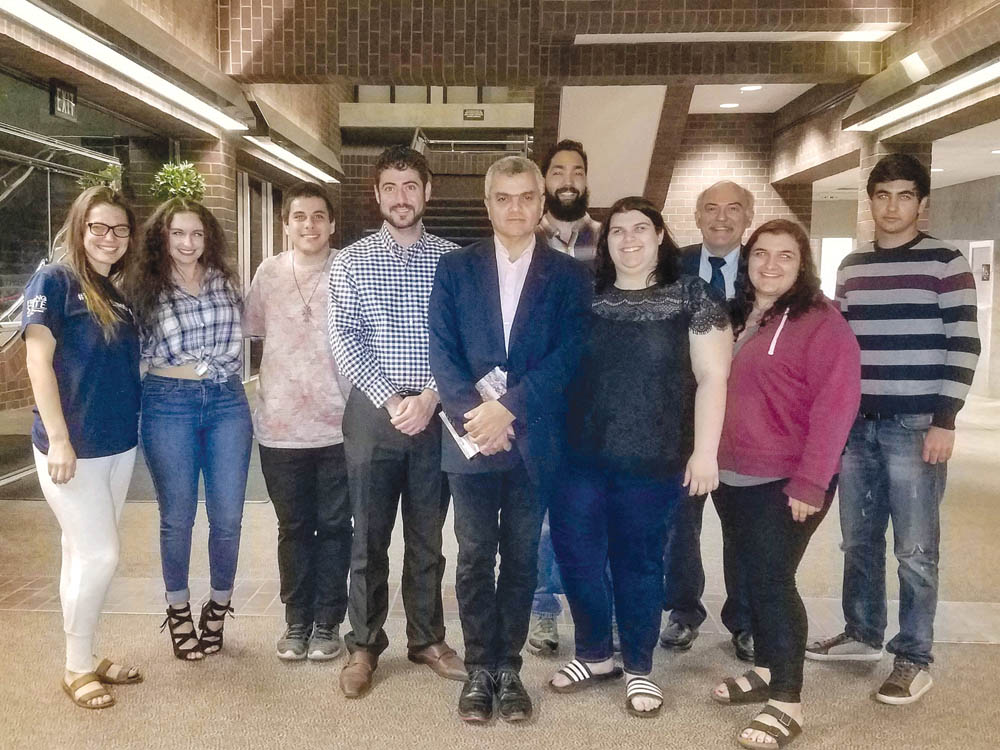
Photo: Christine Pambukyan
David Safrazian
Staff Writer
“Much of Armenian history has been expunged from Turkey, not only in a physical sense, but also in the sense of memory as the names of Armenian villages have been systematically erased,” stated Ara Sarafian. “States write history, and they can write people out of history, and if Armenians don’t write their own history, then their history will also be erased.”
Sarafian, director of the London-based Gomidas Institute, visited Fresno State on Thursday, October 25, to present the new publication Armenians in Ottoman Turkey, 1914: A Geographic and Demographic Gazetteer by Dr. Sarkis Karayan. The book provides detailed information collected over more than 20 years of research documenting the more than 4,000 Armenian towns and villages which existed before the Armenian Genocide.
Dr. Karayan, who was born in Lebanon, began his research into the topic of Armenian demography when educator Dr. Stanley Kerr asked him, “how does one really know how many Armenians were killed in the Armenian Genocide of 1915.” Dr. Karayan concluded that to know how many were lost, you first had to know how many Armenians there were in the Ottoman Empire prior to 1915.
The accepted number of Armenians lost in the Genocide is approximately 1.5 million Armenians, but according to Dr. Karayan, the numbers were greater. Dr. Karayan used Ottoman Turkish sources, and also Armenian documentation to come to his conclusions. According to Dr. Karayan, there were about 2.4 million Armenians living in the Ottoman Empire in 1878, although the official Turkish position is that there were significantly fewer Armenians, in the range of 800,000-1,200,000. This position, repeated by some scholars in the United States, is another dimension of the Turkish denial. After 1915, there were about 2.2 million Armenians who disappeared, so there were more Armenians killed then initially thought. Dr. Karayan’s research helps to undermine the official Turkish historiography of the period.
Dr. Karayan used Armenian sources, which had never before been used, in compiling his demographic data. Among the important records are those found in the Armenian Patriarchate of Turkey. He also used the records of Western European travelers, who visited throughout the Ottoman Empire in the 18th and 19th centuries. His meticulous research will provide the basis for further scholarship in the field.
Dr. Karayan was determined to find the statistics on every village that was inhabited by Armenians in Ottoman Turkey and Armenia. Sarafian stated that Armenians in Ottoman Turkey, 1914 is a significant work because now there is a reliable source for information about the Armenians in the Ottoman Empire in the English language, thus making it more accessible.
Each village or town in historic Armenia and Turkey has both an original Armenian name and a new Turkish name, that is meant to erase the memory of Armenian history. Sarafian demonstrated this by showing various maps with the names of these villages and detailed population statistics of Armenian, Kurds, and Turks who lived in each area.
“Even Turkish people are inter-ested in the topic of demography because they have been denied access to this information about the Armenian Genocide,” concluded Sarafian.
Dr. Sarafian would like to take the book to Turkey, to allow Turks to consider what their own government has said about the Genocide.
The book has an important historical role to play, but it also has a significant political task to combat continued denial of the Armenian Genocide.
 Hye Sharzhoom Armenian Action
Hye Sharzhoom Armenian Action